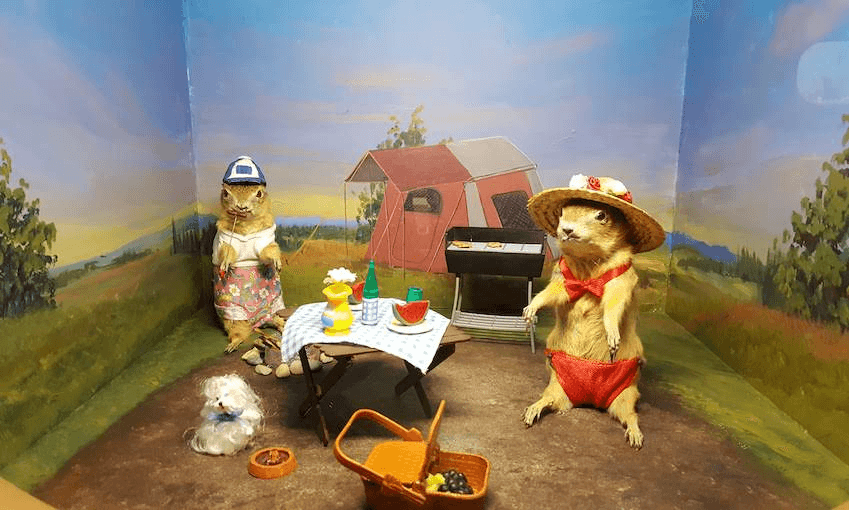A small Canadian town has the weirdest answer to its pest problem – a museum of stuffed and costumed animal dioramas that has become a cult tourist attraction.
Possums, stoats and rats are giving our native birds grief, and the New Zealand government has outlined an ambitious plan to get rid of them. All of them. That’s some 30 million possums and lord only knows how many rats and stoats.
Which begs the question: Once these animals have been trapped or poisoned out of existence, what will we do with their furry little bodies?
One option might be to make dioramas starring stuffed versions of these villains, like they have in the hamlet of Torrington in Canada.
Torrington is a 170 person community situated about an hour and a half north of former Olympic-city Calgary. Blink and you miss it. The tiny town is known for one thing, and one thing alone: gophers.
Greeting you creepily as you round the bend into Torrington is Clem T. GoFur, a three and a half metre tall mascot grinning gleefully while casually leaning on a wagon wheel. All of the town’s 11 fire hydrants are painted to look like gophers and, according to local Terry Lang, are all members of the same GoFur family.
Why the obsession with this rodent? The area is overrun with them, and not just in the statue or fire hydrant sense. They’re a pest to farmers, churning up soil, devouring crops and digging holes that horses or cattle stumble into. “They cause a lot of havoc,” Lang told The Spinoff during a recent visit. “In spring you can literally see the ground rolling with gophers.”
Then, in the early 90s, Torrington, like much of the rest of the province, was deep in an economic recession. They wanted a way to draw tourists to their blip on the map and had been given a modest CA$3,000 (roughly NZ $3,600) to do so. The Torrington Gopher Hole Museum was born in an old school house off the main drag. It killed two birds with one stone, so to speak, boosting tourist numbers and disposing of the creatures plaguing their agricultural mainstay.
Lang, who was on duty at the museum when we visited, told The Spinoff they didn’t think the museum would last a year. “It was desperation… We thought no one is going to come and see a gopher,” she said. It’s now going on a decade and a half and the museum draws around 6,000 visitors during their short June to September season. “It’s just spiralled. We don’t know why. We don’t know how. We’re still in shock,” Lang said.
The museum boasts 49 displays containing 77 taxidermied Richardson’s ground squirrels (not technically gophers). It’s a modest establishment: just a single, dimly lit room with a noisy radiator, which helps prevent the stuffed displays from decaying, Lang told us.
The room looks like a 70s vision of a spaceship harbouring creatures on a long journey. Peer inside any one of the displays and you’ll find two or three rodents posed in scenes ranging from pastimes like hunting or camping, to local business settings, like “Torrington Go 4 Fuel and Parts”. There’s even a display that takes a dig at P.E.T.A, who heavily criticised the museum upon opening, and a travelling display made especially for the 2010 Vancouver Winter Olympics.
It’s a real DIY, community effort, with locals manning the till, guiding tours, deciding on a new display every two years, trapping the gophers in the fields, sewing gopher costumes, crafting props and painting backdrops to bring the scenes to life. Lang, a septuagenarian, painted the gift shop a few years ago. “If we can fix it ourselves, we do. If we have to call somebody in, it’s desperate,” she says.
The museum has grown to be more than a weird pest solution. It’s a time capsule of the area’s rural history, showcasing the traditional yearly jamboree, businesses that have come and gone and the evolution of local buildings, from old homes to the modern skating rink.
New Zealand could follow Torrington’s lead. Ohura on the North Island or Otematata on the South could, for example, be contenders for the small town hosting their very own rodent diorama paradise. Each has a population in the low two hundreds.
And with the country’s pest trapping efforts ramping up in the buildup to Predator Free 2050, surely there’ll be plenty of fuzzy carcasses to go around. There is one catch though. Current New Zealand trapping methods leave rats, stoats and possums in quite a state. Torrington’s gophers are snared with a rope as they emerge from their holes, leaving them prime for taxidermy.
According to Department of Conservation spokesperson Herb Christophers, the best way to dispose of the animals after trapping is to leave them in the bush to decay or be gobbled up by a predator. At-home trappers should throw them in the garbage or compost, he told The Spinoff.
Still, there’s no denying the impact tiny Torrington has made on the world stage. They’re in the Ripley’s Believe it or Not book, host visitors from all over the globe, and even got a former Disney animator to paint a mural on the museum building. All from finding a creative way to make lemonade out of lemons. Or, dioramas out of a pest.

